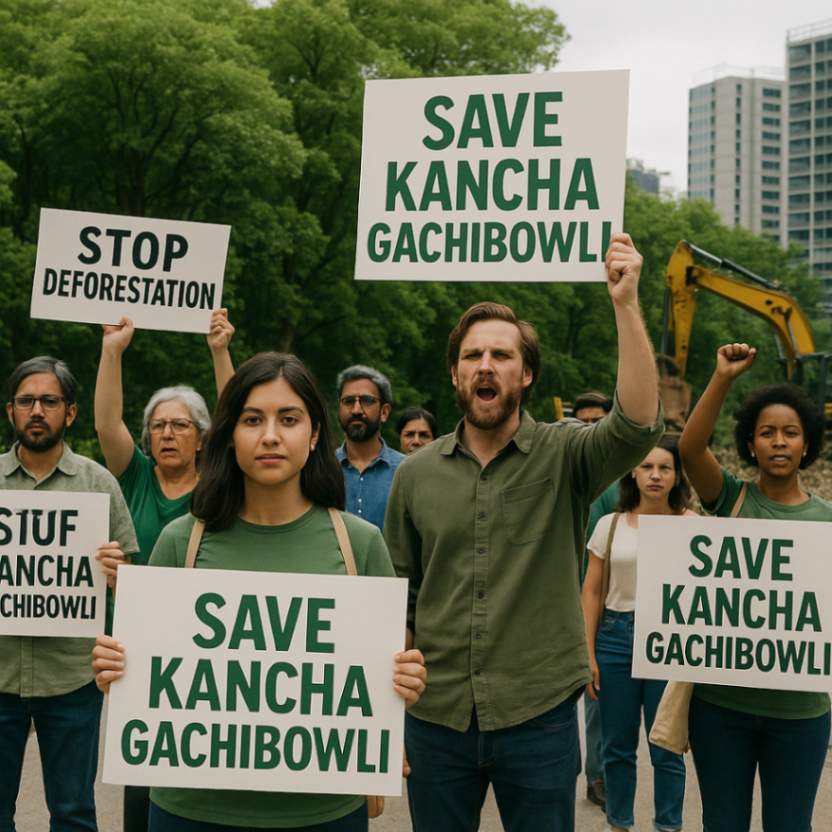Supreme Court Steps In: A Landmark Intervention in the Kancha Gachibowli Forest Dispute
Save Kancha Gachibowli — As the controversy over the proposed auction and deforestation of the Kancha Gachibowli forest auction, the matter inevitably reached India’s apex court. What began as a state-level development initiative quickly snowballed into a high-stakes battle between environmental preservation and commercial expansion — and the Supreme Court’s intervention has become a significant moment in the legal history of urban environmental protection. This movement, now symbolized by the rallying cry “Save Kancha Gachibowli,” reflects a growing public outcry not just against ecological degradation, but for a broader vision of sustainable urban development in India’s cities.
Background: From Land Auction to Legal Battle
The Telangana government’s plan to auction approximately 400 acres of land in Kancha Gachibowli stirred intense opposition in early 2025. The government, through the Telangana State Industrial Infrastructure Corporation (TSIIC), had intended to utilize the land to expand the IT corridor and attract private investment.
However, residents, environmental groups, and students from the neighboring University of Hyderabad raised serious objections. The site in question wasn’t barren or degraded land — it was a thriving urban forest ecosystem, home to over 200 bird species, natural lakes, reptiles, and native tree species. Widespread protests, sit-ins, and online petitions began making waves.
Recognizing the ecological significance and the large-scale felling of trees already underway, several environmental groups and public interest advocates filed petitions in court, challenging the legality of the state’s actions and demanding immediate intervention.
Supreme Court’s Order: Halting the Chainsaws
In a crucial hearing held in April 2025, the Supreme Court of India issued a status quo order on the ongoing deforestation and development activity in the Kancha Gachibowli region. The court ordered the Telangana government to stop all tree-felling activities immediately, citing concerns about irreversible ecological damage.
Key highlights from the Court’s remarks:
-
The bench noted that “unregulated urban expansion cannot come at the cost of critical ecosystems.”
-
It stressed the need to balance development with sustainability, especially in metropolitan cities that are already battling rising temperatures and falling air quality.
-
The Court took serious note of the fact that no comprehensive Environmental Impact Assessment (EIA) had been conducted before the auction process was initiated.
The directive required the state to:
-
Submit a detailed report on the biodiversity, forest cover, and environmental value of the Kancha Gachibowli land.
-
Cease all further construction, auctioning, or clearance activities until further hearing.
-
Justify the classification of the land as “non-forest” despite clear ecological indicators.
Legal and Ecological Implications
The Supreme Court’s intervention in this case sets a critical precedent for how urban forests and ecologically sensitive zones are treated, even if they are not officially listed as “reserved” or “protected” under conventional forest laws.
According to several environmental law experts, this action:
-
Reinforces the expanded definition of ‘forest’ laid out in the 1996 Godavarman judgment, which includes not just designated forests, but any land with significant tree cover and biodiversity.
-
Validates the growing role of citizen-led activism in environmental governance.
-
Could influence urban planning policies across India, where green spaces are often sacrificed for infrastructure.
Public Sentiment and Continued Resistance
The Supreme Court’s decision was met with celebration among conservationists and students who had been tirelessly campaigning to “Save Kancha Gachibowli.” The judgment was seen not just as a win for the forest, but also for participatory democracy and ecological consciousness.
Social media hashtags like #SaveKanchaGachibowli and #GreenHyderabad trended once again, and more citizens joined calls to declare the area an official Urban Forest Reserve or Biodiversity Heritage Site.
What’s Next for the Forest?
While the Supreme Court has temporarily halted the auction and deforestation, the case is still under judicial consideration. The following outcomes are now possible:
-
The land could be permanently protected under environmental law if classified as a forest.
-
The government might be compelled to relocate any proposed development to areas with lower ecological value.
-
A comprehensive Environmental Impact Assessment (EIA) may become mandatory for any future action in this region.
The Telangana government, meanwhile, has indicated it may review its plans and is reportedly exploring the idea of turning the area into an eco-park — a potential compromise, though conservationists remain wary of “greenwashing” tactics that still lead to habitat disruption.
Conclusion: Forests Have a Voice, and It Was Heard
The Supreme Court’s stay order has paused what could have been one of Hyderabad’s most devastating ecological losses in recent years. But more than just a legal victory, it represents a shift in how we value urban nature — not as unused land waiting for development, but as living, breathing systems essential to our future.
The Kancha Gachibowli forest isn’t just a patch of trees. It’s a sanctuary of biodiversity, a climate stabilizer, and now, a legal landmark in India’s fight for environmental justice.


